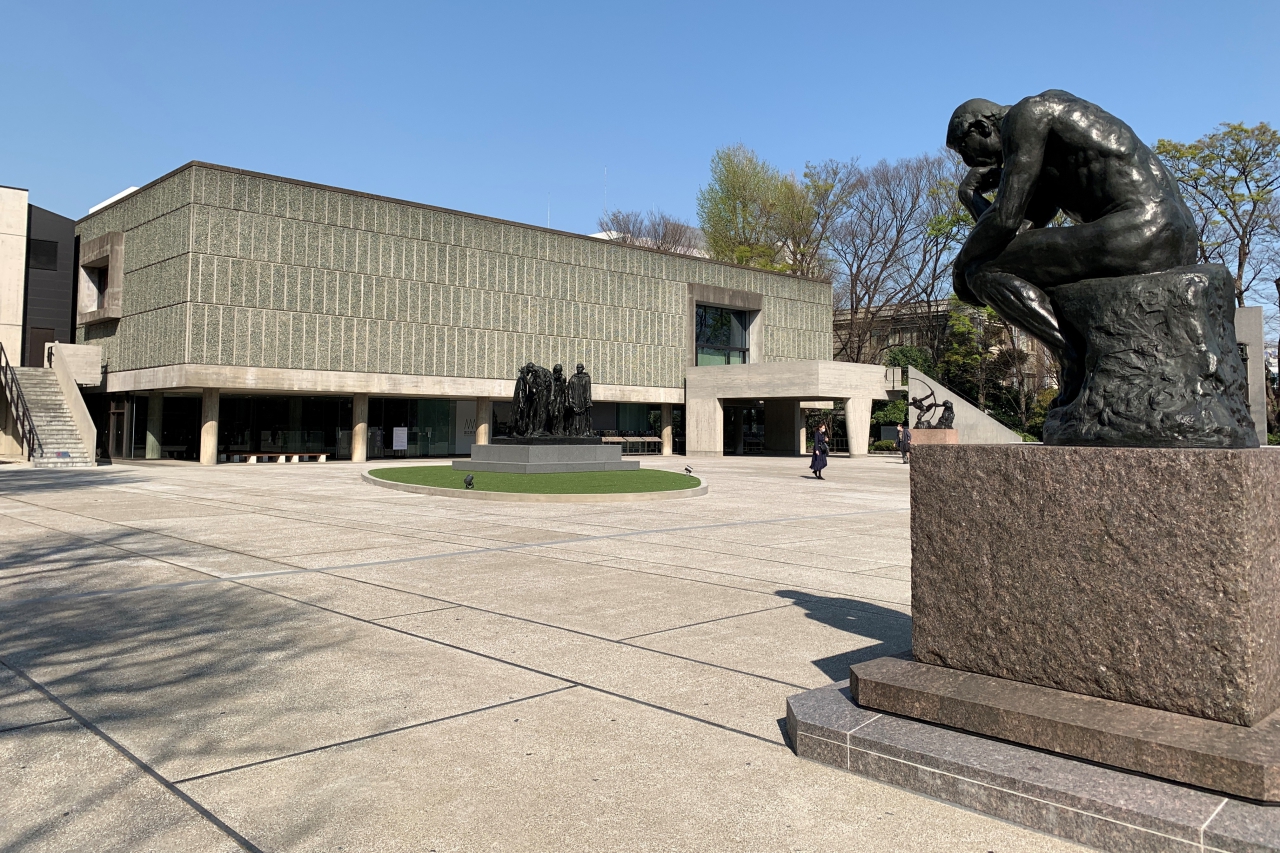
The National Museum of Western Art (Ueno, Tokyo), which had been closed for about a year and a half due to facility maintenance, was reopened on April 9, 2022!
In this article, the front yard, designed by French architect Le Corbusier (1887-1965), who is called the "father of modern architecture", has been restored to its original appearance in 1959, and is open to the public for free. A detailed report on changes after the renewal, such as "Century Hall" .
At the same time, we will also introduce the newly opened small exhibitions "Toward Harmony: The Second Machine Age of Le Corbusier Art-From the Taisei Collection" and "New Collection Print Collection Exhibition".
The National Museum of Western Art, which is closer to what it was when it opened
At the press conference and renewal preview held the day before the reopening, I quickly visited the National Museum of Western Art after construction.
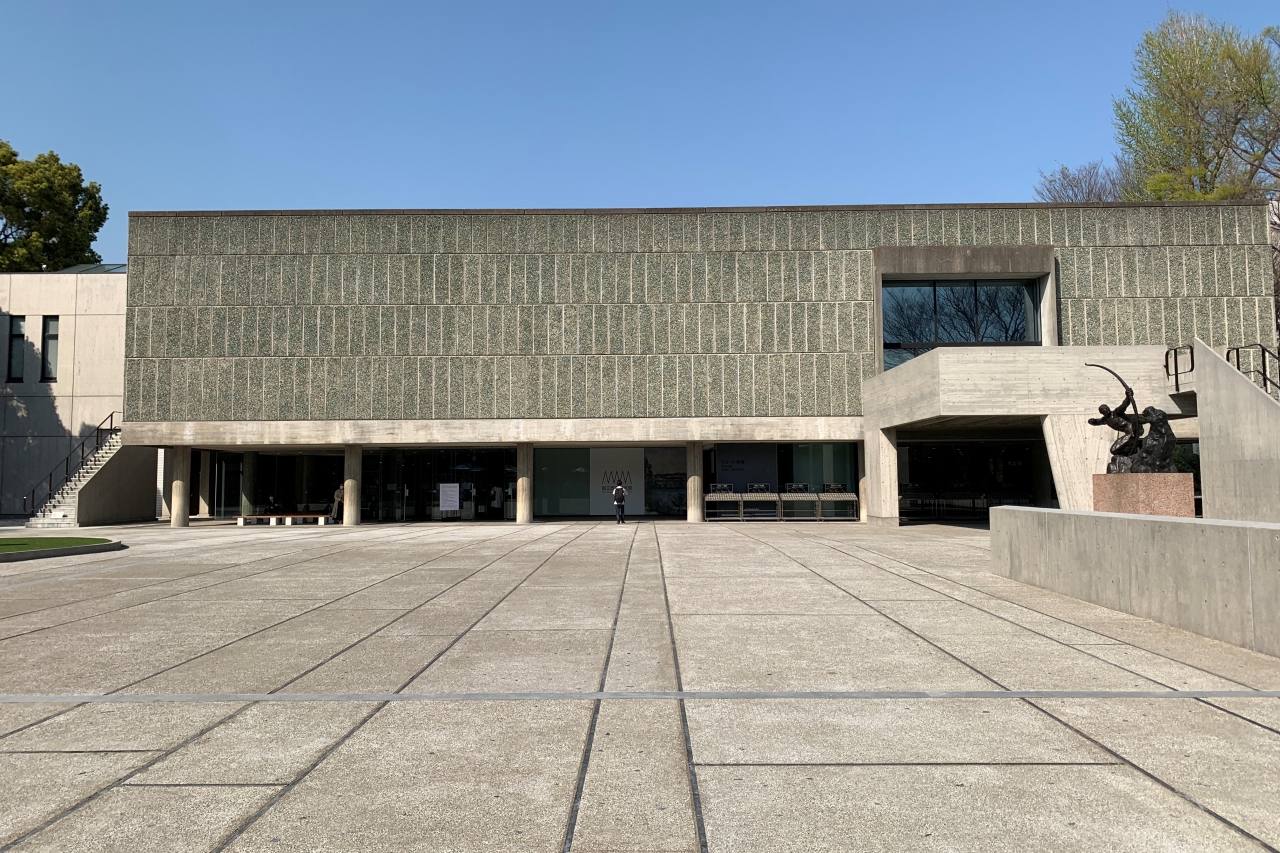
A view from the south entrance of the National Museum of Western Art
In the construction work that started in October 2020, the air conditioning and waterproof equipment of the exhibition hall were renewed, but the appearance of the front yard is what you can see and feel the renewal.
The front yard of the museum has undergone various modifications since its opening in 1959. This was to improve the function and convenience of the museum, but when the entire site including the main building and the front yard was registered as a UNESCO World Cultural Heritage site in 2016, the original design intention of the front yard was partially lost. It seems that he was pointed out that he was being damaged.
Therefore, in order to convey the intention designed by Le Corbusier correctly and to increase the value of the building, the museum decided to return the front yard to the original appearance as much as possible in accordance with the facility maintenance .
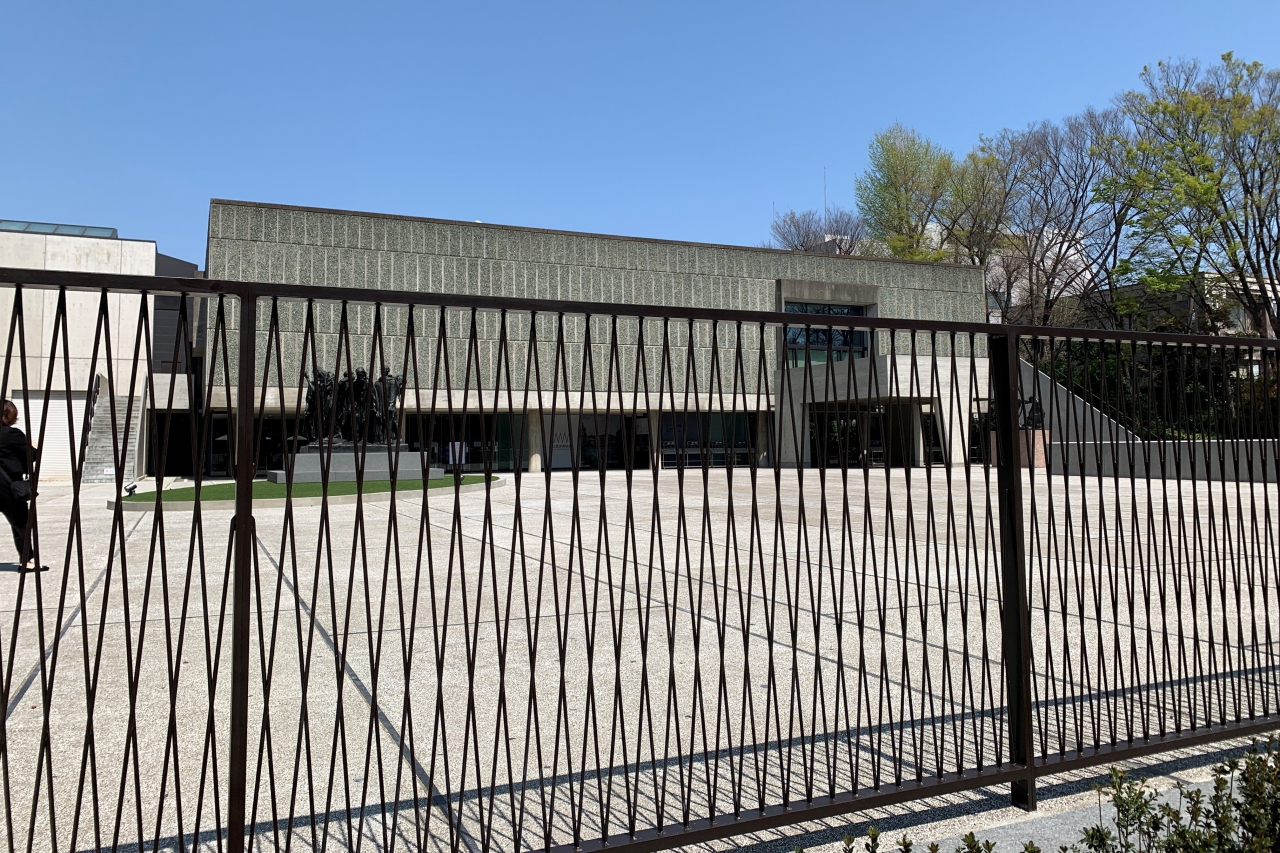
So that you can see the site from the garden road.
The first thing I noticed when I visited the museum after the renewal was that the plants on the southwest side were almost removed and that the site of the museum was clearly visible from the garden road of Ueno Park. ..
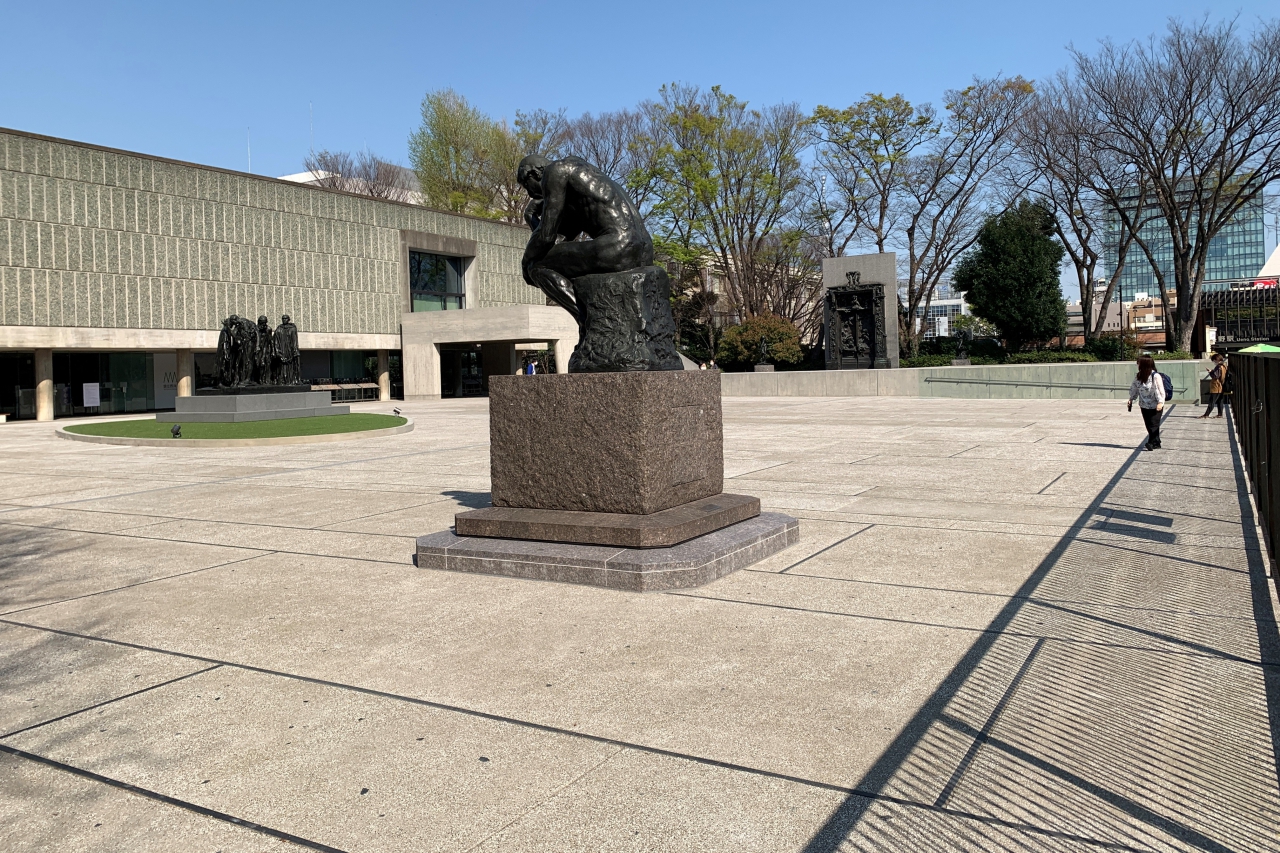
A view from the southwestern edge of the site. Almost all the plants have disappeared.
If you have seen the appearance before the renewal, please remember the scene at that time.
The photo above is the place where there was a planting area with a path before the renewal. It was a lot refreshing!
The front yard had a slightly closed atmosphere due to the planting and the fence surrounding the site, but this time it has been restored to the appearance of an open open space at the time of opening. In order to maintain continuity with Ueno Park, the fence was made transparent as it was at the time of opening, so that the line of sight can be seen from both the garden road side and the museum side.
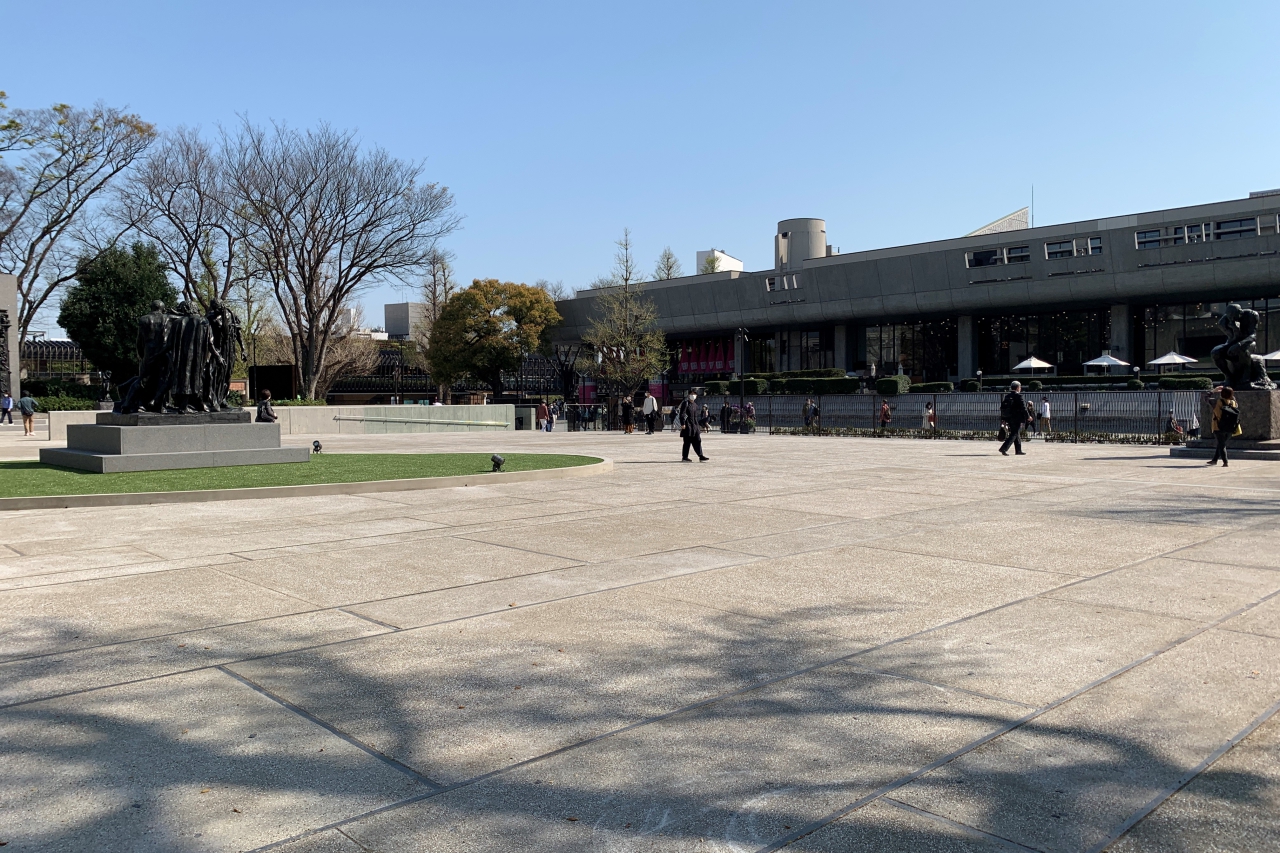
Make sure you can see the Tokyo Bunka Kaikan on the other side.
The approach to the main building and the arrangement of the sculptures, which Le Corbusier had in mind, were as close as possible to the original appearance of the museum.
First, the entrance on the west side (fountain square side), which was once treated as the main gate, has a shape close to the original state. At the same time, the floor line drawn to guide visitors from this western entrance has also been restored.
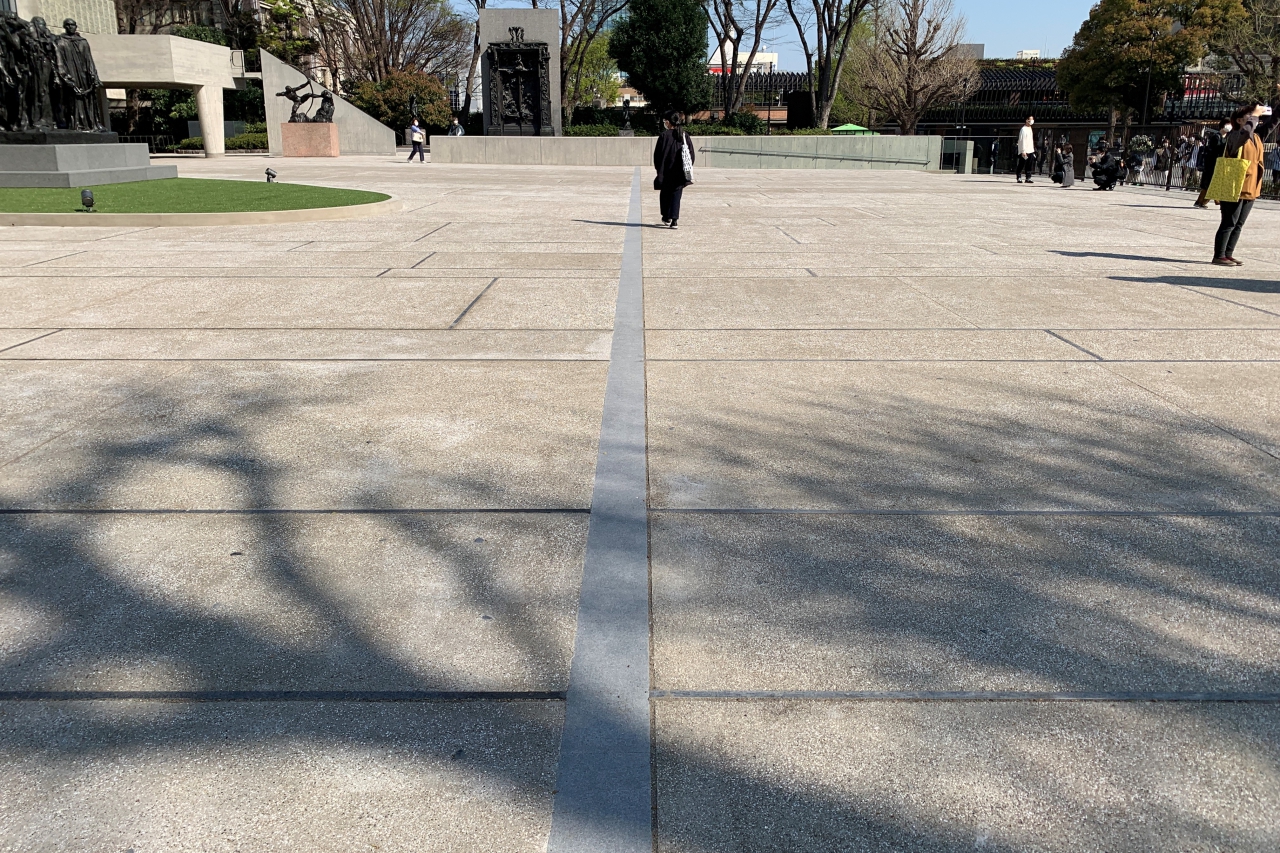
A gray line extending from the western entrance in the direction of "Gate of Hell".
The floor line extends straight to the east towards the Gate of Hell. Along the line, while watching Rodin's "The Thinker (enlarged work)" on the right and "Citizen of Curry" on the left, the line branches to the left and invites people into the main building.
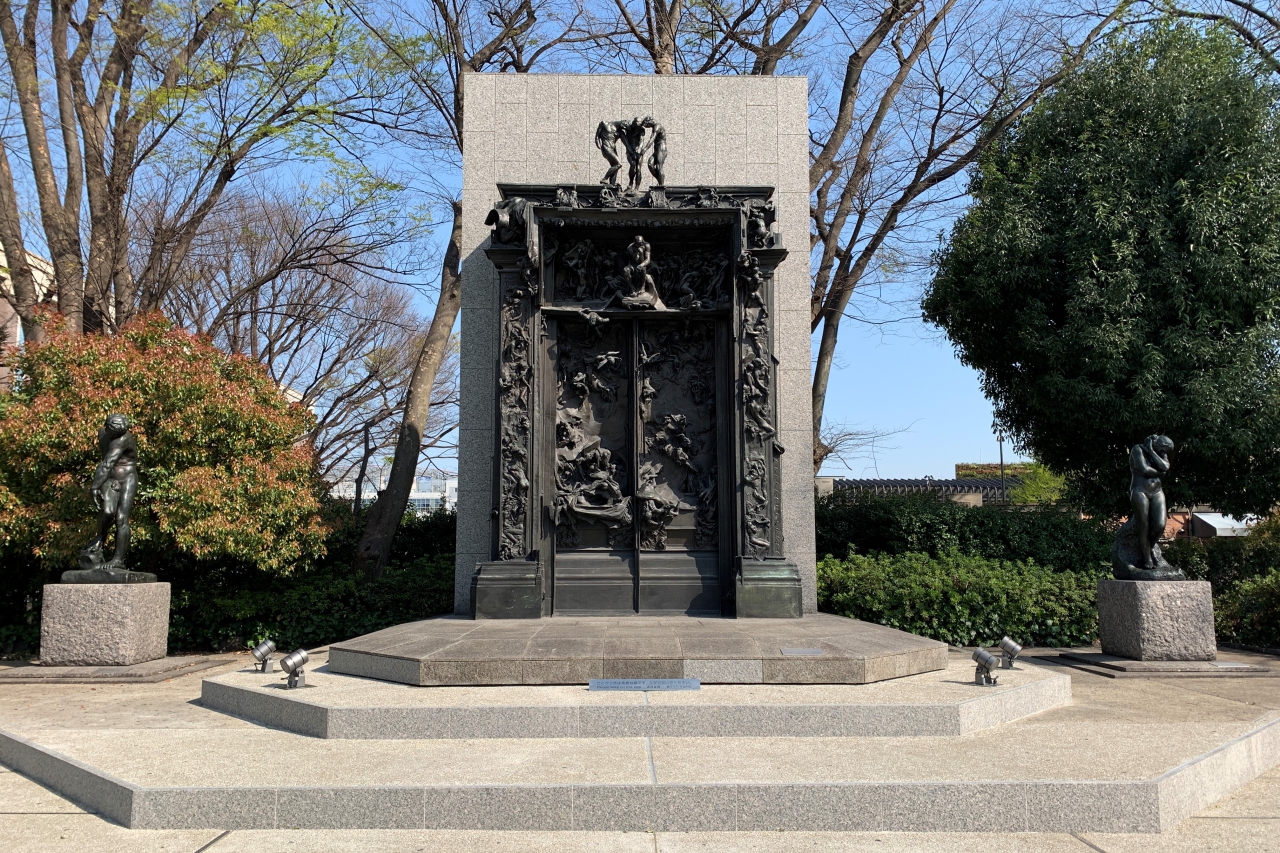
"The Gates of Hell" at the end of the line / Auguste Rodin "The Gates of Hell" Matsukata Collection
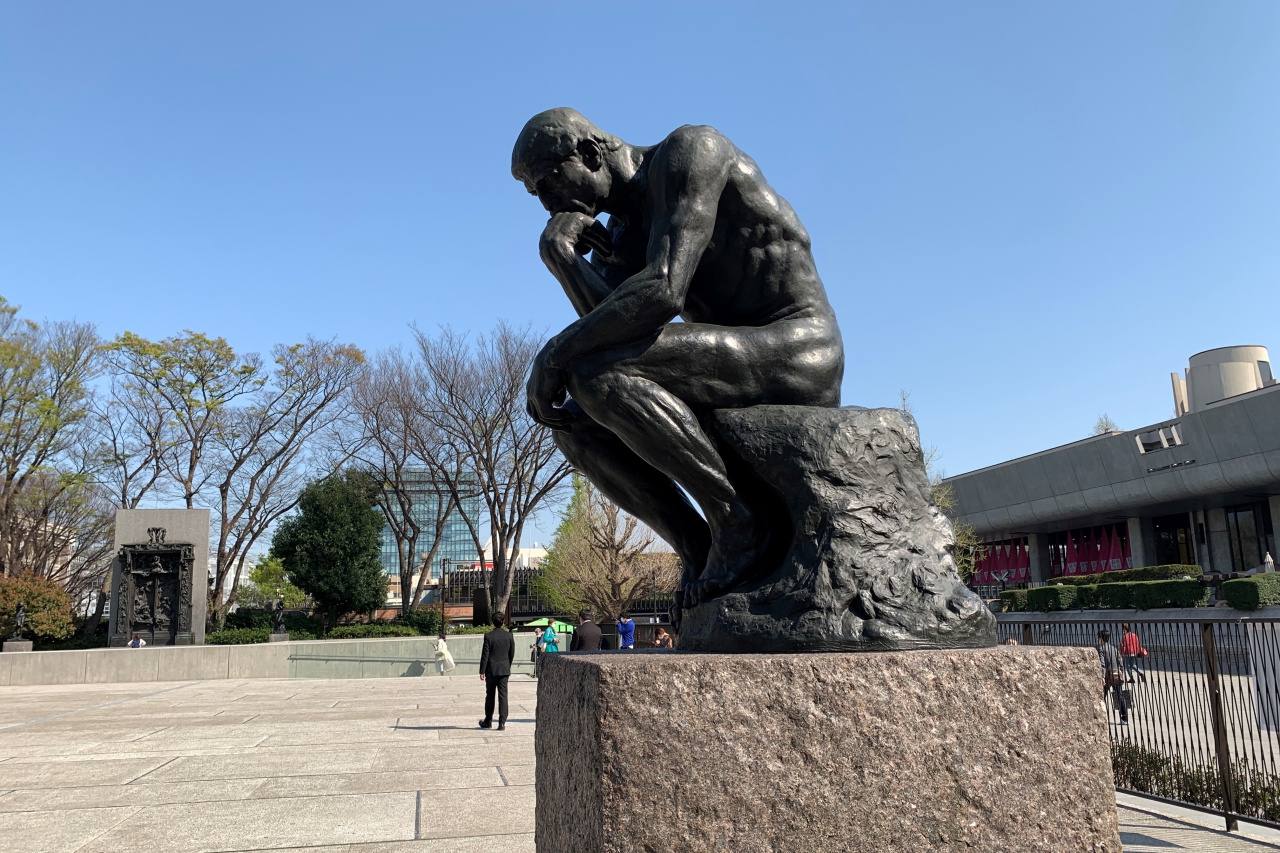
Auguste Rodin << The Thinker (enlarged work) >> Matsukata Collection / It is installed facing the visitors who entered from the western entrance.
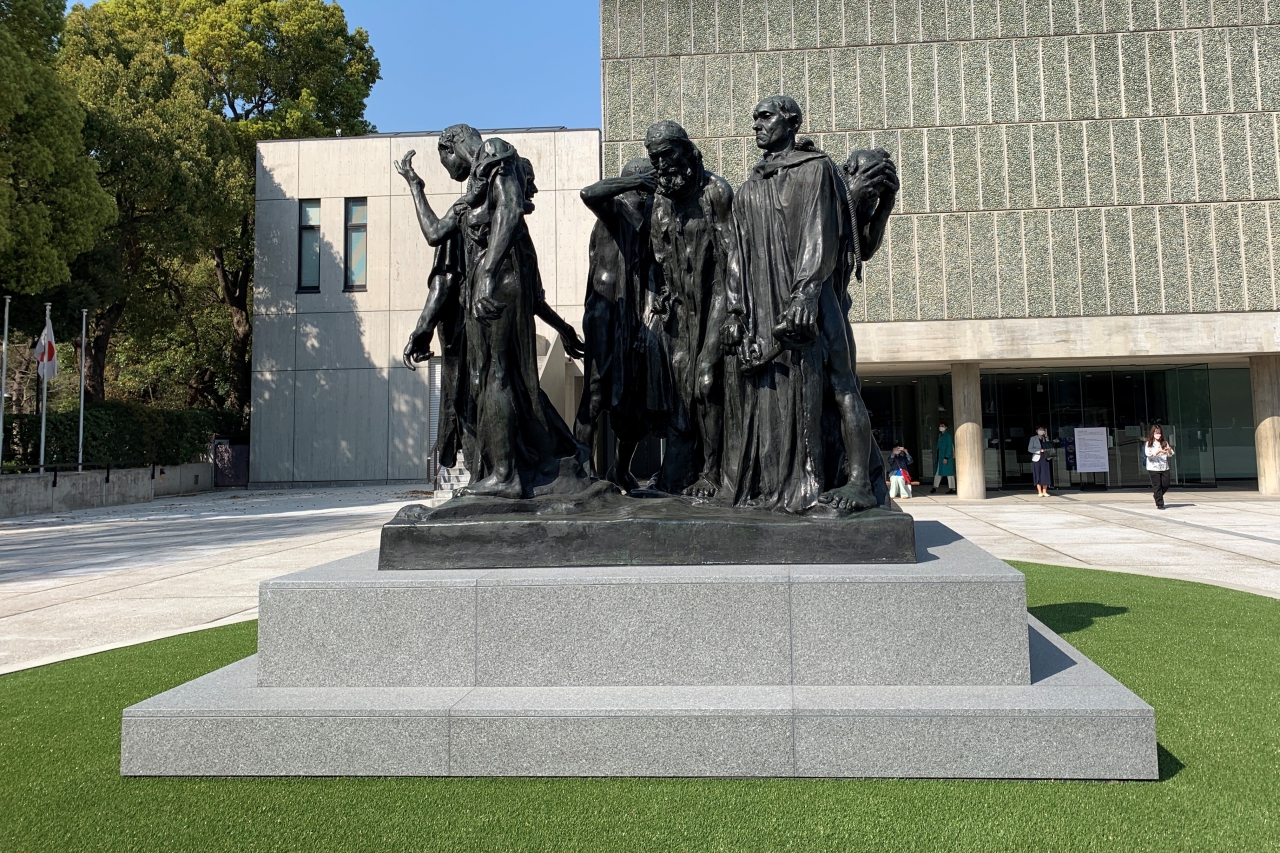
Auguste Rodin "Citizen of Curry"
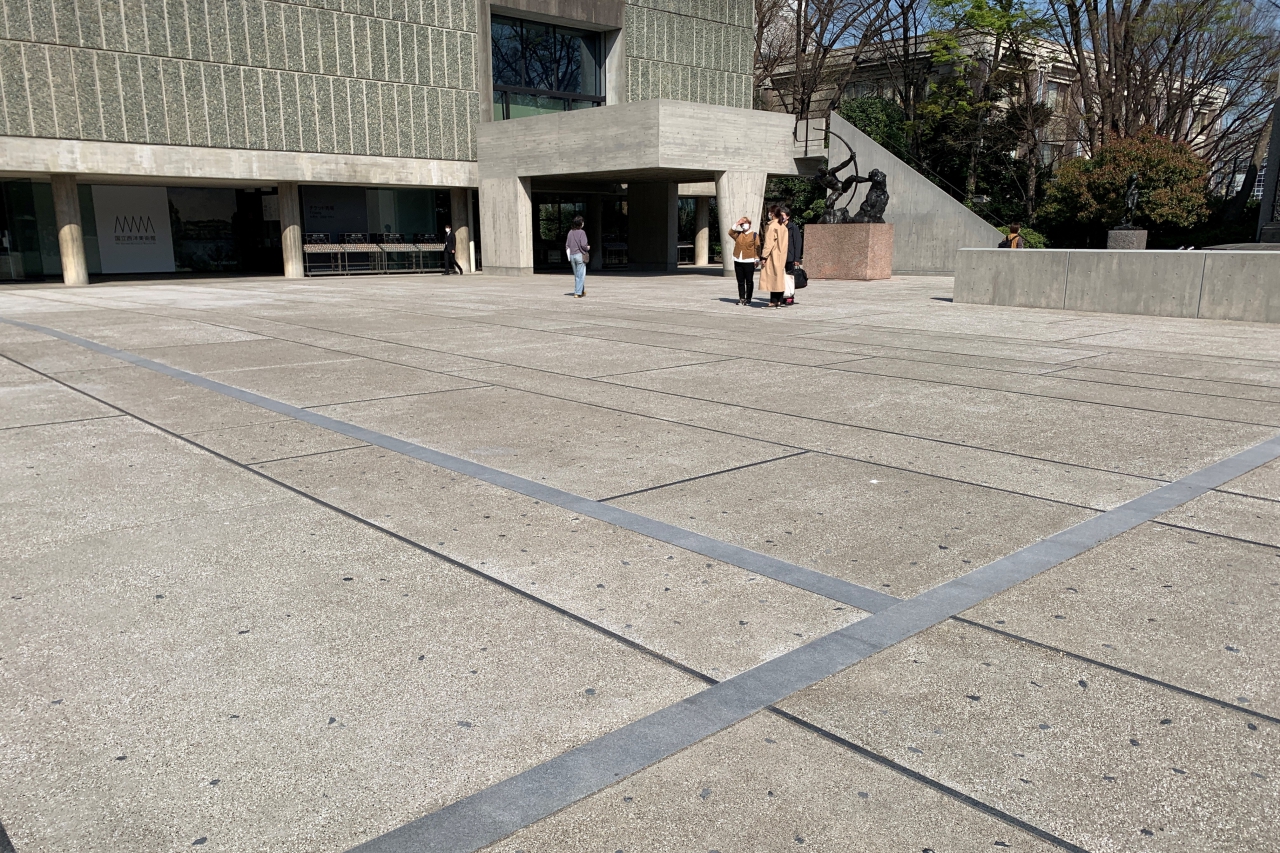
The line branches to the main building on the way.
At the time of design, Le Corbusier envisioned an "infinite growth museum" in which a core room was first created in the center, and as the collection increased, the exhibition space was expanded in the form of a spiral around the outside.
Kyo Fukuda, an expert at the museum, said, "The flow continues from the front yard to the piloti (a space with a colonnade consisting of only pillars), which is the concept of the Museum of Infinite Growth, and then to the central hall. However, as you shift your gaze, the scene changes one after another, and Le Corbusier often uses the technique of inviting people to move in a natural direction without using signs such as arrows. "
Also, on the floor of the vestibule, you will notice that in addition to the flow lines, fine joints spread out like a ghost leg.
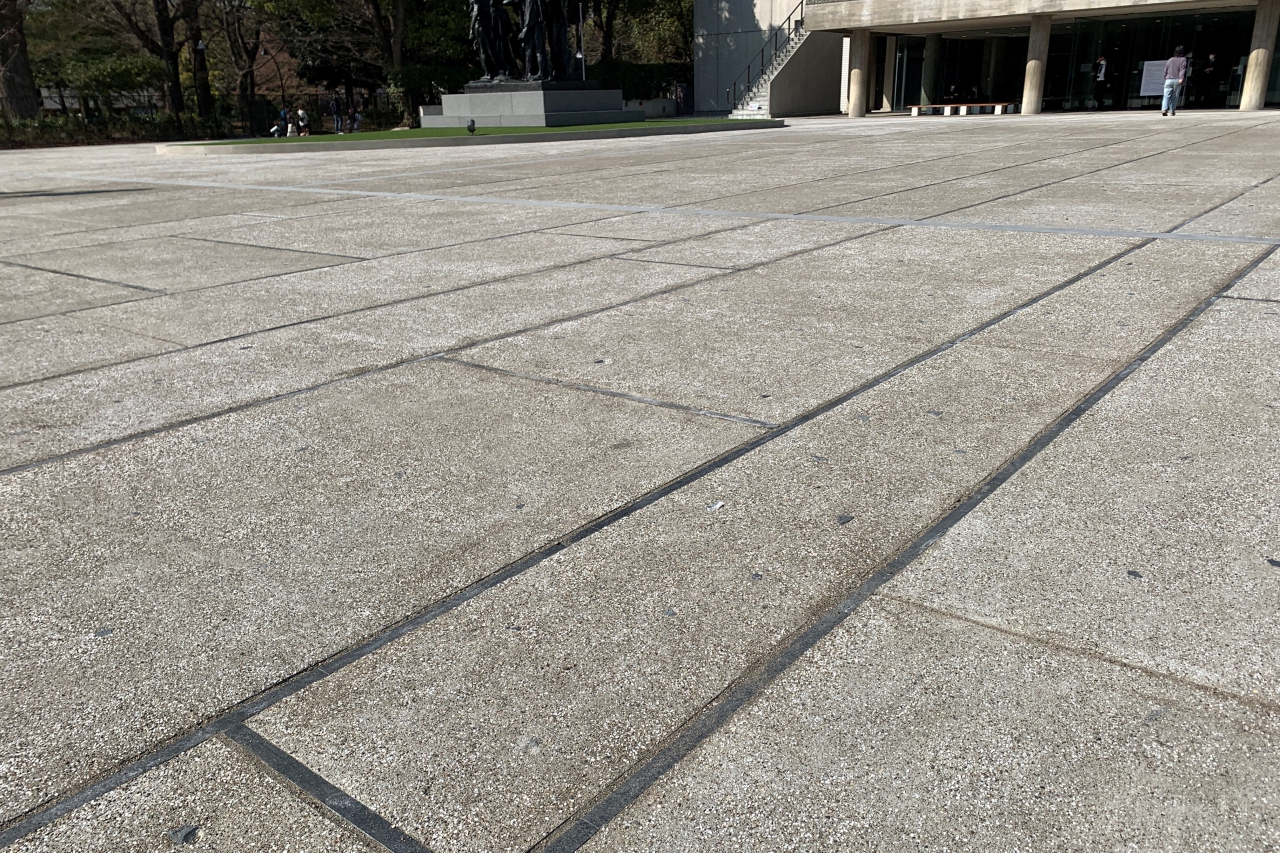
A joint that spreads all over the front yard.
This is assigned by "Modulor" , a scale devised by Le Corbusier based on the dimensions and golden ratio of the human body. Before the renewal, the joints as the original design and the joints that divide the concrete panel were mixed, making it difficult to understand the design. Also, it seems that the position of some of the joints as a design has changed from when it opened.
With this renewal, the joints of the concrete panels have also been allocated with Modulor so as not to spoil the aesthetics, and the details have been restored.
By the way, regarding the joints on the floor of this front yard, it seems that the width and position of the sashes on the window of the Tokyo Bunka Kaikan opposite are completely compatible!
The design of the Tokyo Bunka Kaikan was done by Kunio Maekawa, a disciple of Le Corbusier who was also involved in the design of the National Museum of Western Art, so is it a homage to his master? Please compare them when you visit.
The atrium space "19th Century Hall" in the main building is open for free!

Hall of the 19th century
Upon reopening, the atrium space "19th Century Hall" in the center of the main building, which used to be a paid area, will be open for free for the time being! (A viewing ticket is required from the slope leading to the exhibition room on the 2nd floor)
The "19th Century Hall", where the appearance of soft natural light entering from the triangular skylight is impressive, is a place where the space itself is like a sculpture. It is the starting point of the permanent exhibition, and if you go up the slope to the second floor, you can see the exhibition rooms arranged in a corridor shape so as to surround the hall.
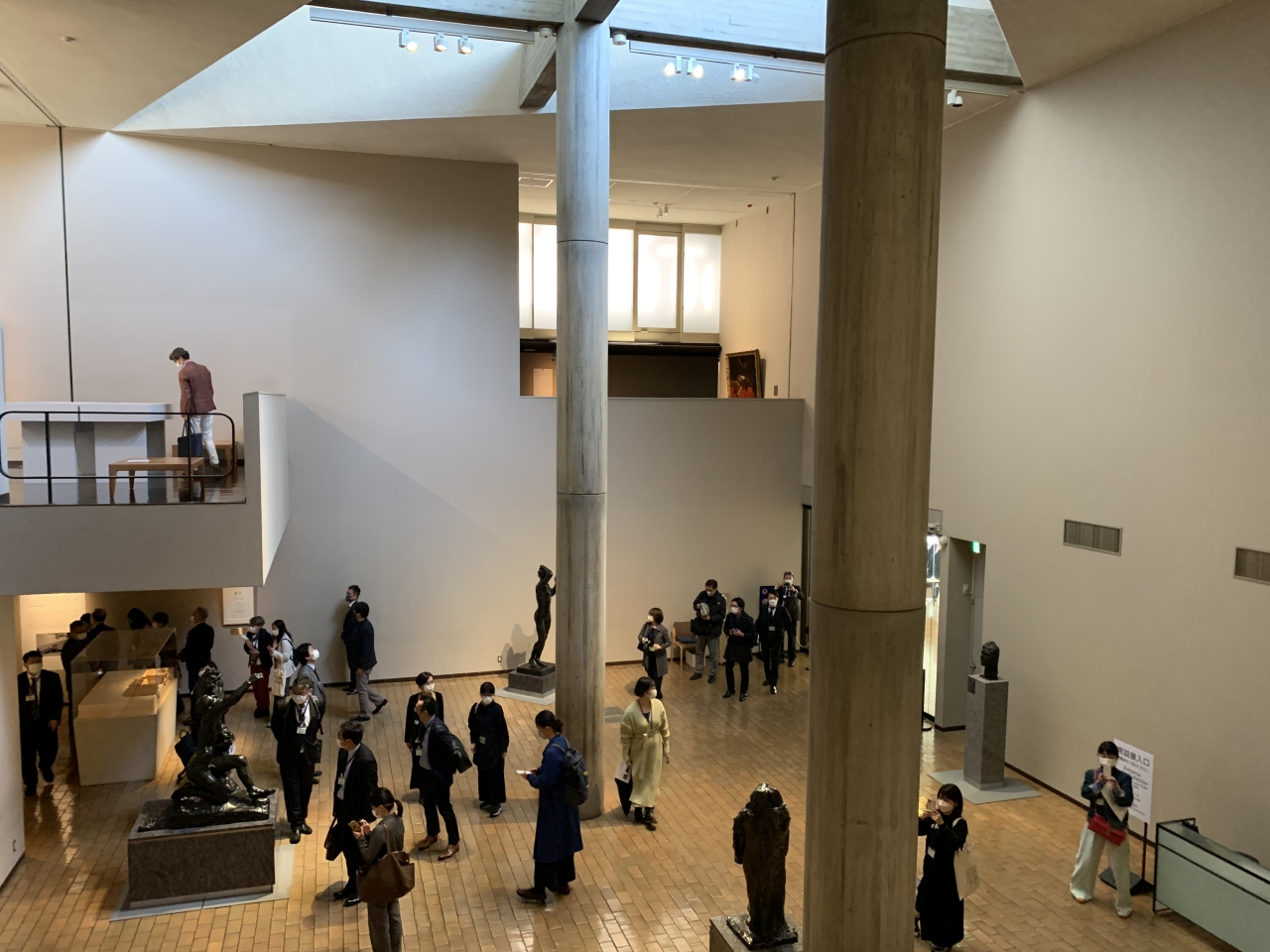
View from the 19th Century Hall Slope
The spiral flow line starting from the "19th Century Hall" reflects the idea of Le Corbusier's "Museum of Infinite Growth". If you climb the gently sloping slope, you can see the paintings on the second floor behind the pillars … Again, you can enjoy the scenery that changes while you move. Experience the world of Le Corbusier in the "19th Century Hall" along with the renewed front yard.
There is a new mechanism in the permanent exhibition!

Permanent exhibition Exhibition scenery
There is also a change in the permanent exhibition where you can appreciate Western paintings and modern French sculptures from the Middle Ages to the 20th century, centered on the "Matsukata Collection" built by businessman Kojiro Matsukata.
The permanent exhibition is full of works by masters representing the times, such as Monet of "Water Lily", Delacroix, Rubens, Cezanne, Renoir, Van Gogh, Picasso and so on. It is an exhibition full of incredible highlights that you can put in for 500 yen.
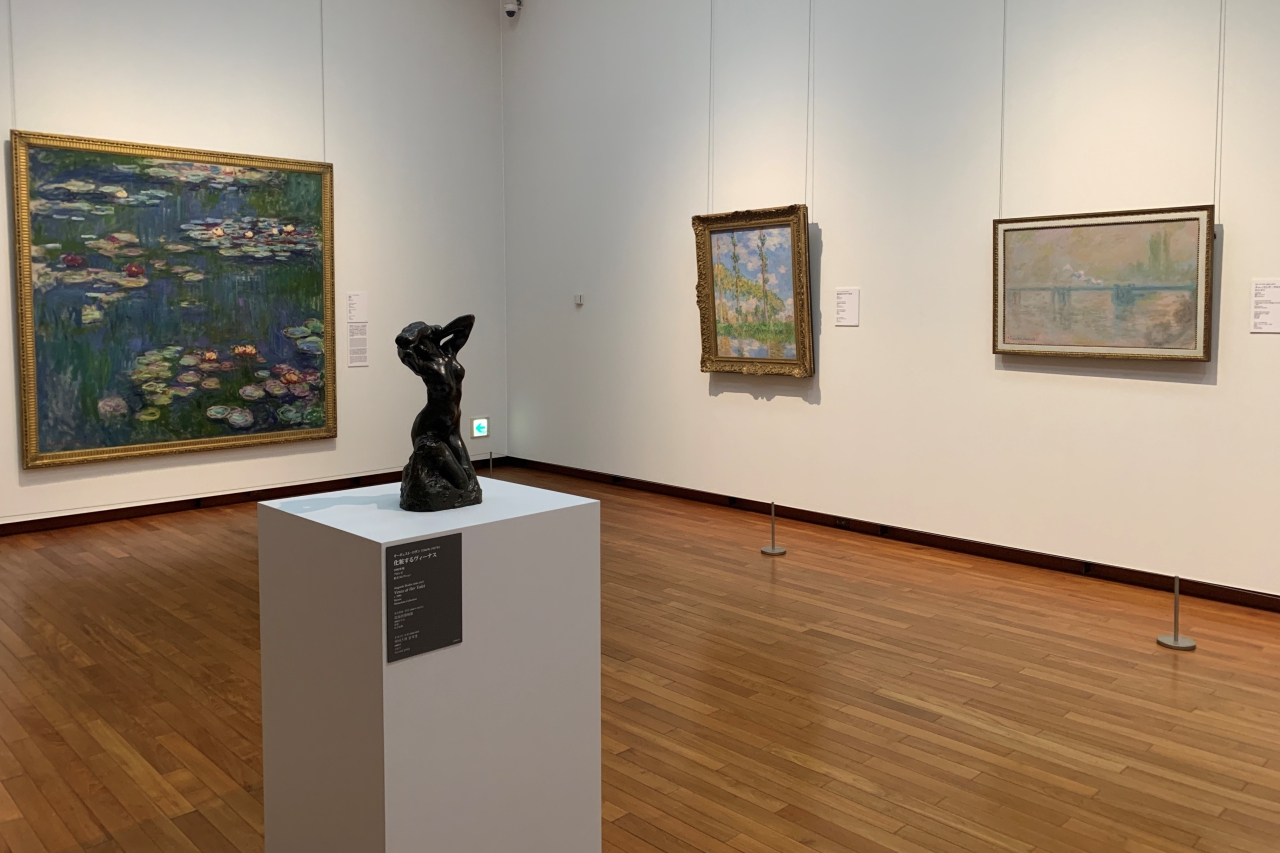
Permanent exhibition Exhibition scenery
According to Director Masayuki Tanaka, the exhibition method of the permanent exhibition has been reconsidered in line with the renewal, and the works are arranged in a slightly different way.
"It's a secret exhibition, with modern works mixed in with old-age paintings. Look at why modern works are mixed there and what you're trying to show. I would appreciate it. " There is also a new pickup introduction section for the work "Collection in FOCUS", so please check it out.
I would like to introduce some of the works that may be new faces of the permanent exhibition, such as new collection works and first exhibition works.
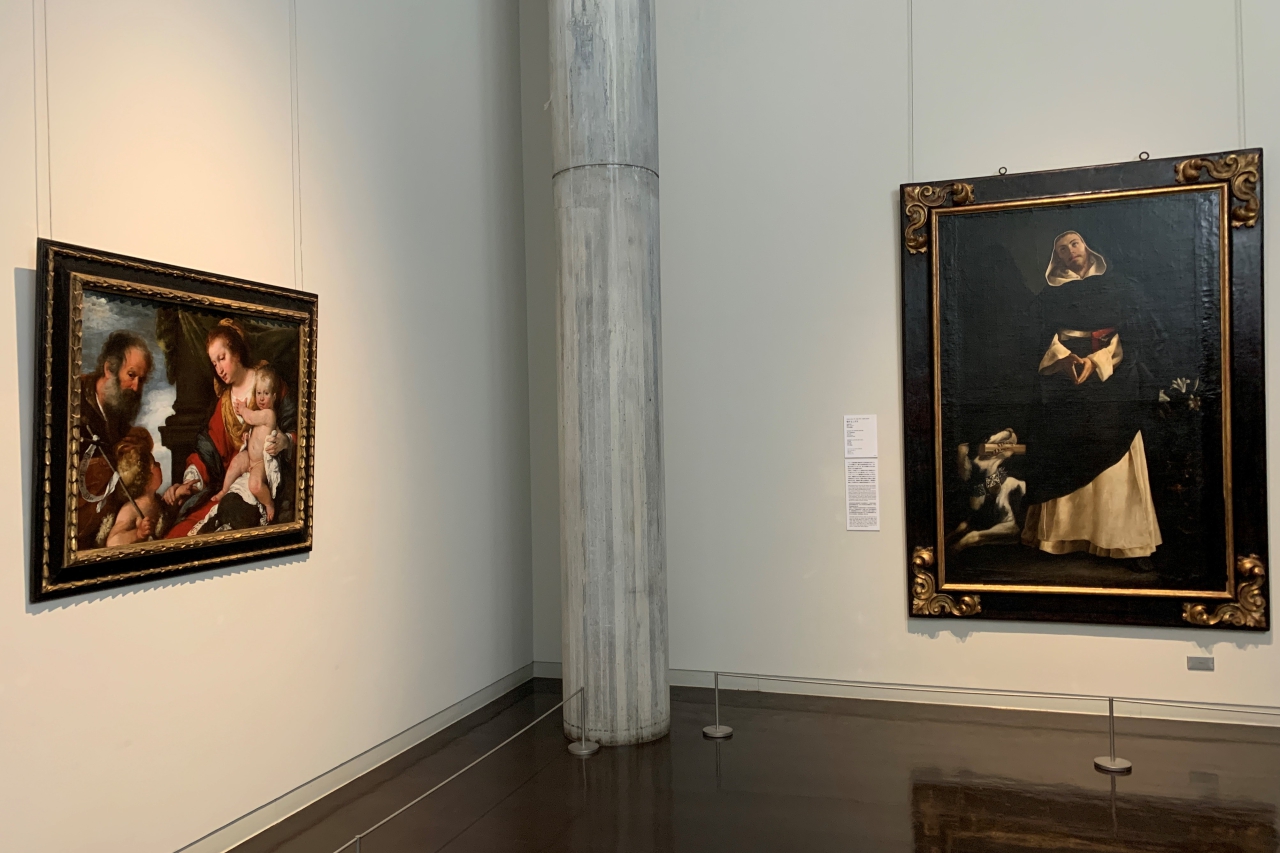
(Left photo) [New collection] Bernardo Strozzi "Holy Family and Infant Baptist St. John" Early 1640s, oil painting, canvas
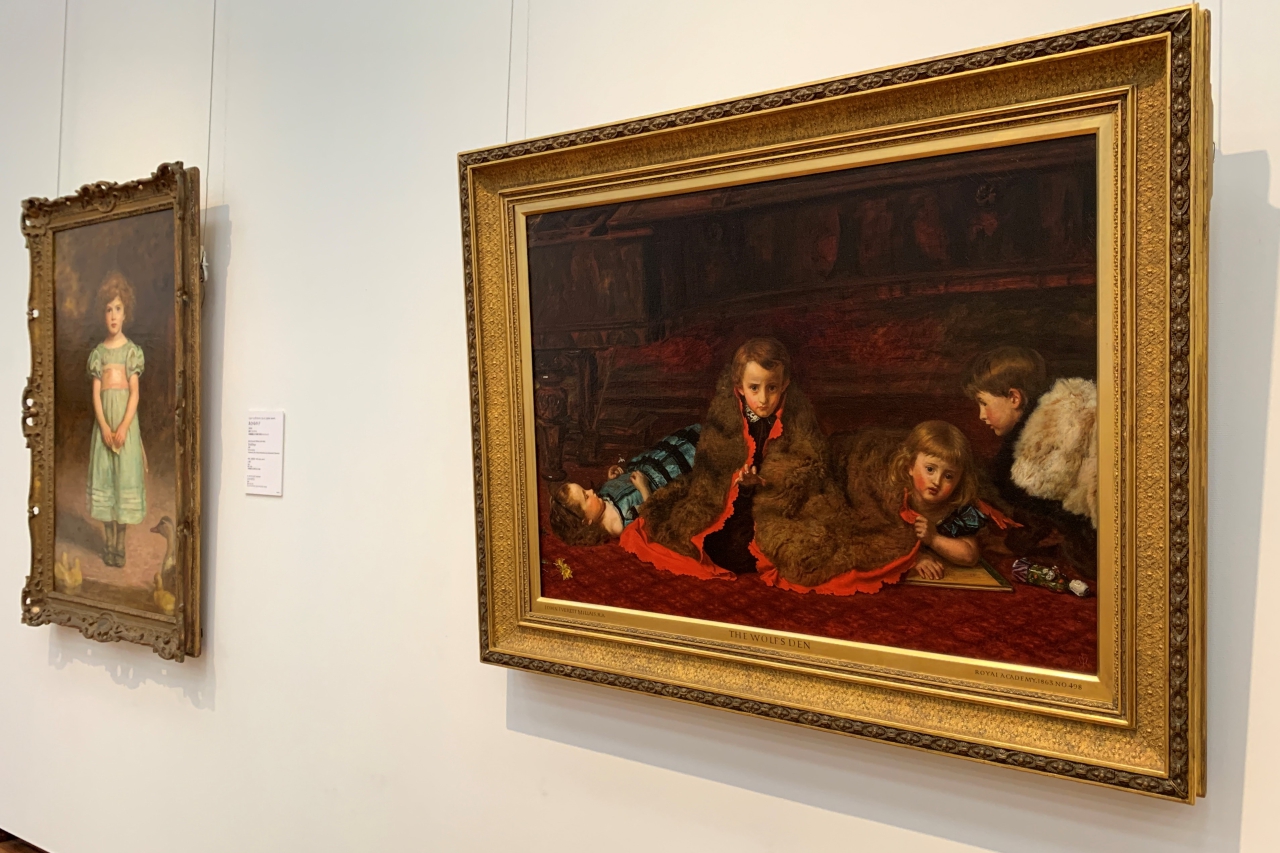
(Right photo) [New collection] John Everett Millais "Wolf's Nest" 1863, oil on canvas
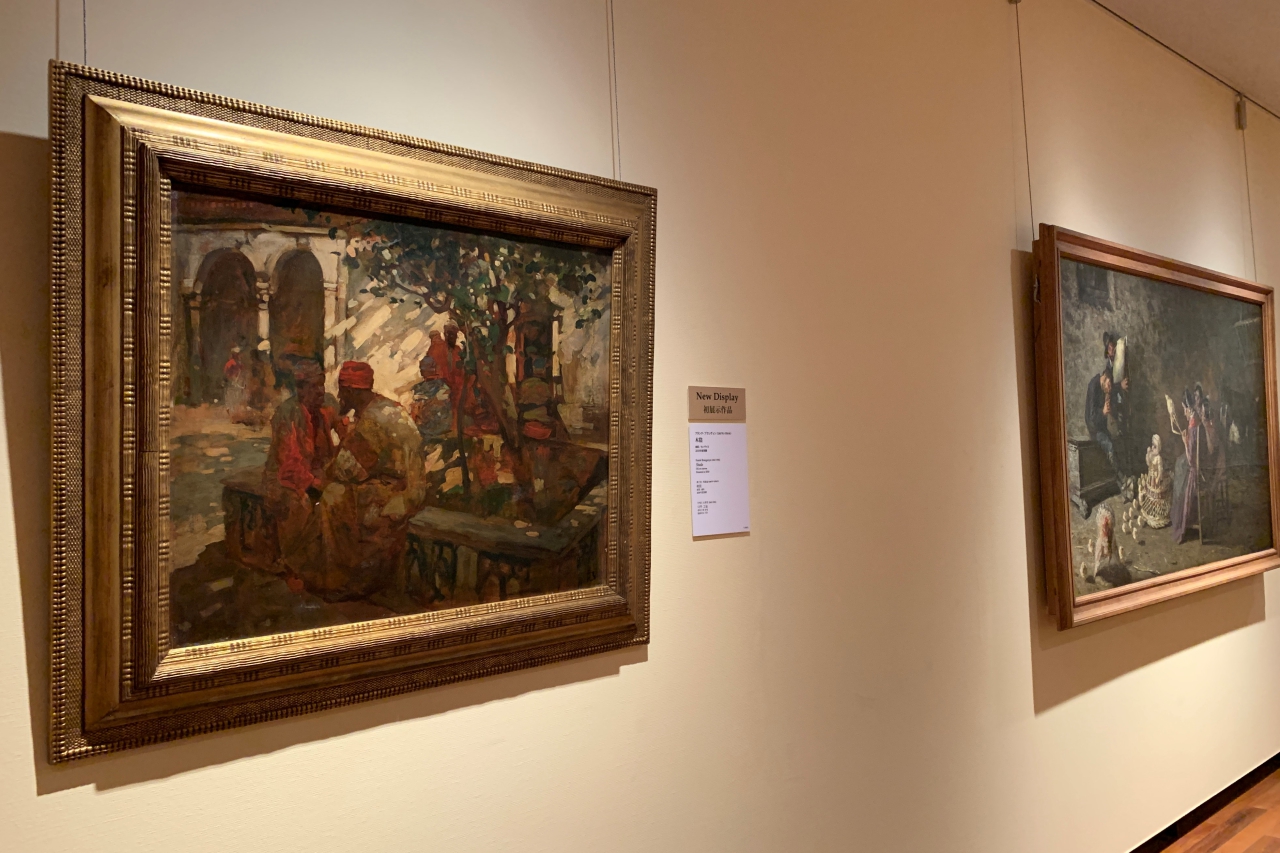
(Left photo) [First exhibition work] Frank Brangwyn "Shade" Oil on canvas

(Left photo) [First exhibition work] Joseph Israël << Old man smoking a cigarette >> Oil on canvas
Since it was a big deal, I took a leisurely tour of the permanent exhibition. Personally, the exhibition room of this permanent exhibition is a fun place to have a moment when I feel like I'm lost in a forest without an exit, "Where am I now?" Does the fact that the walls are installed like blindfolds in some places give an unpredictable feeling and a maze feeling? I felt the essence of "Infinite Growth Museum" even in such a place.
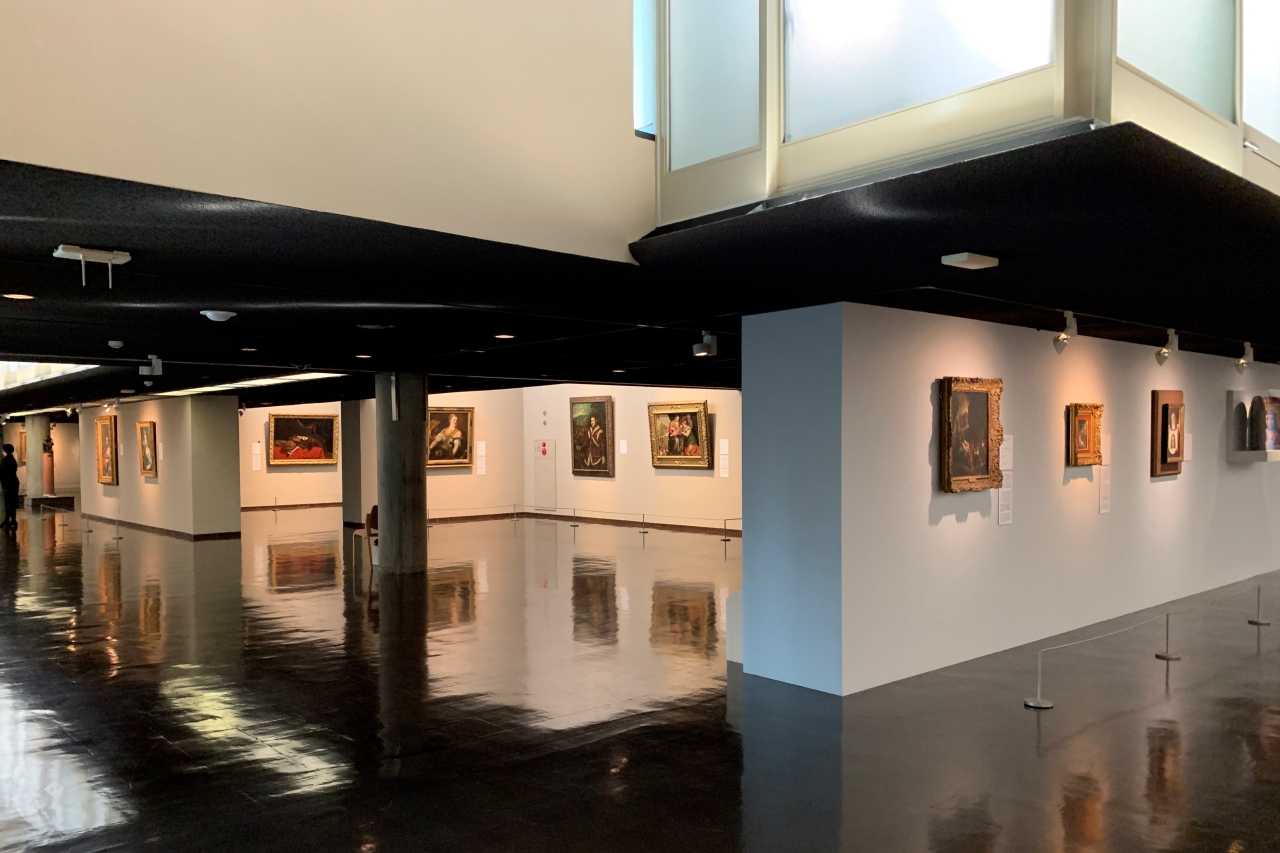
Permanent exhibition Exhibition scenery
Two types of small exhibitions will open at the same time!
A small exhibition "Towards Harmony: The Second Machine Age of Le Corbusier Art-From the Taisei Collection", which introduces paintings and drawings produced by Le Corbusier in his later years from April 9th, in line with the reopening. Is being held.
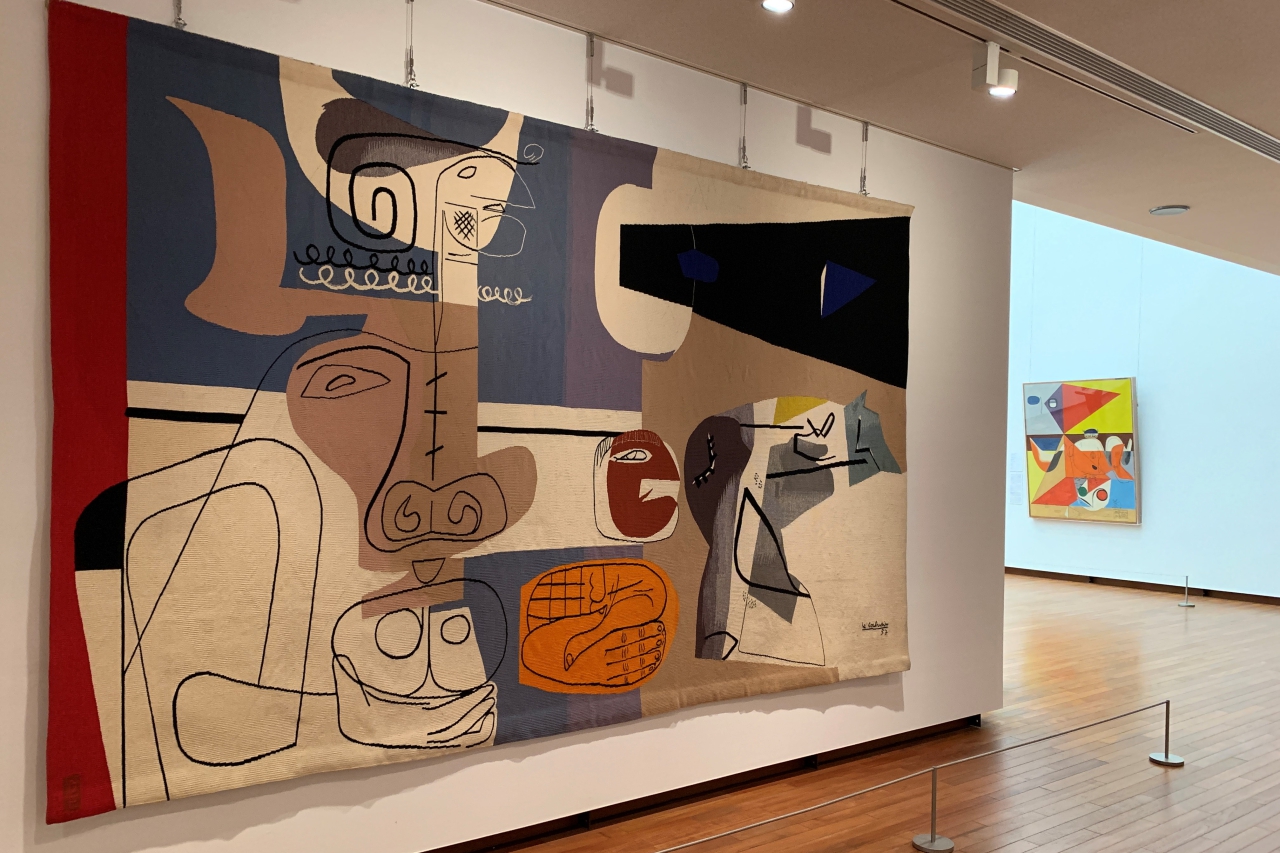
Le Corbusier << Strange Birds and Bulls >> 1957, Tapestry Taisei Corporation (Deposited at the National Museum of Western Art)
Approximately 20 works (about 30 including replacement) will be exhibited, centered on the works deposited by Taisei Corporation, which holds the world's leading collection of Le Corbusier.
A lineup of works that have changed direction from the early Purist style and aimed at the fusion of natural figures and strict geometric compositions, and the harmony between humans and machines, emotions and rationality, and art and science. It seems to be a thing, but at my level, I didn't really understand that. (I was watching the pictures of animals while thinking that they were charming and cute)
The images do not overlap so much between the building and the painting. However, when I watched this small exhibition after going around the National Museum of Western Art, I was wondering, "Oh, I wonder if this building and the creator of the work are the same."

(From the left in the photo) Le Corbusier "Still" 1953, oil painting, canvas "Bowl XVIII" 1959, Gouache, canvas, all owned by Taisei Corporation (deposited at the National Museum of Western Art)
I heard that the dimensions of "Modulor" mentioned earlier are used not only in the front yard but also in various parts of the main building. For that reason, I feel that a unique rhythm and harmony is born in the space. Is there an overlap between the architecture where regularity and unexpectedness coexist and the painting which seems to be unordered and harmonious as a whole? It was an exhibition that I imagined.
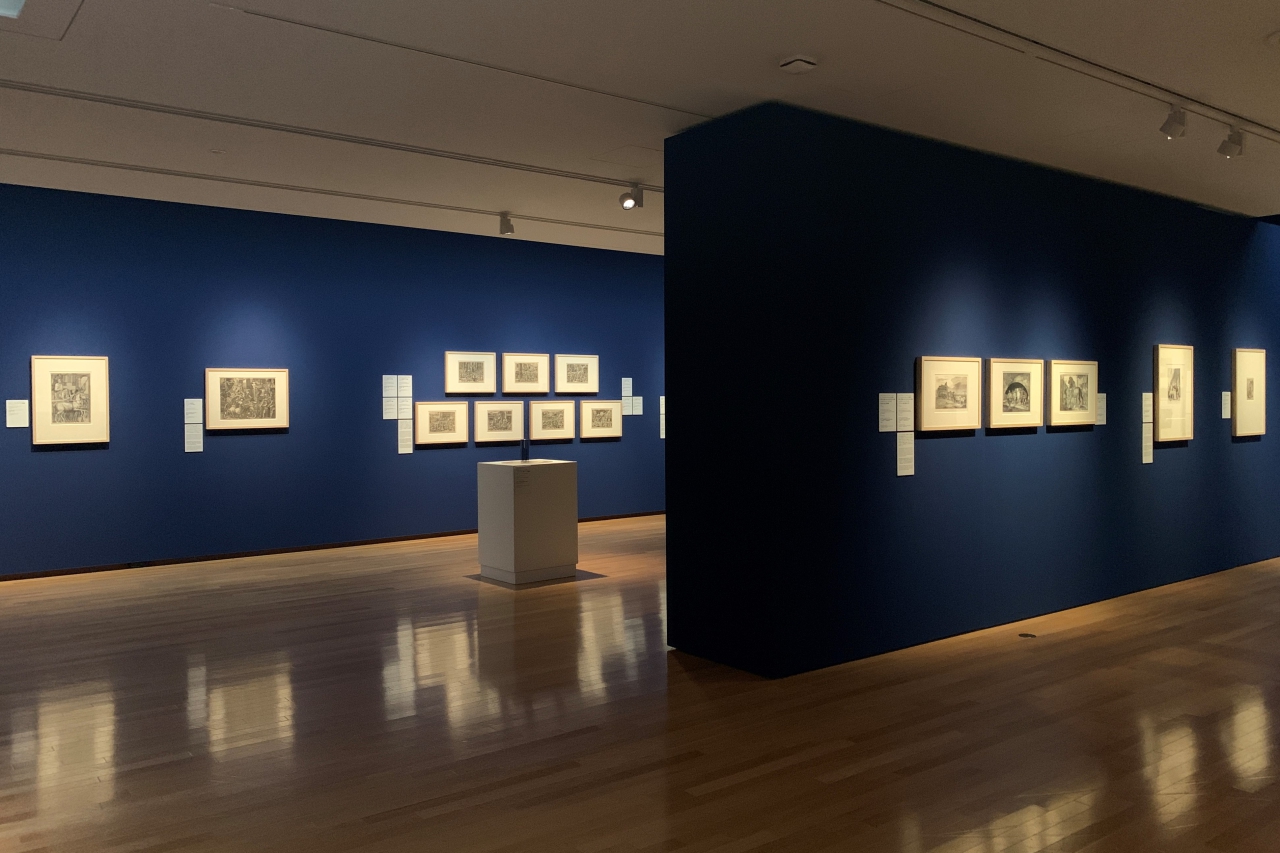
"New Collection Print Collection Exhibition" Exhibition Scene
At the "New Collection Print Collection Exhibition" that opened at the same time, we will introduce works that have been newly collected since 2015 from the print collection of the museum, which has more than 4,500 items. From the end of the 15th century to the beginning of the 20th century, you can enjoy a variety of print expressions, including works by masters such as Durer and Rembrandt.
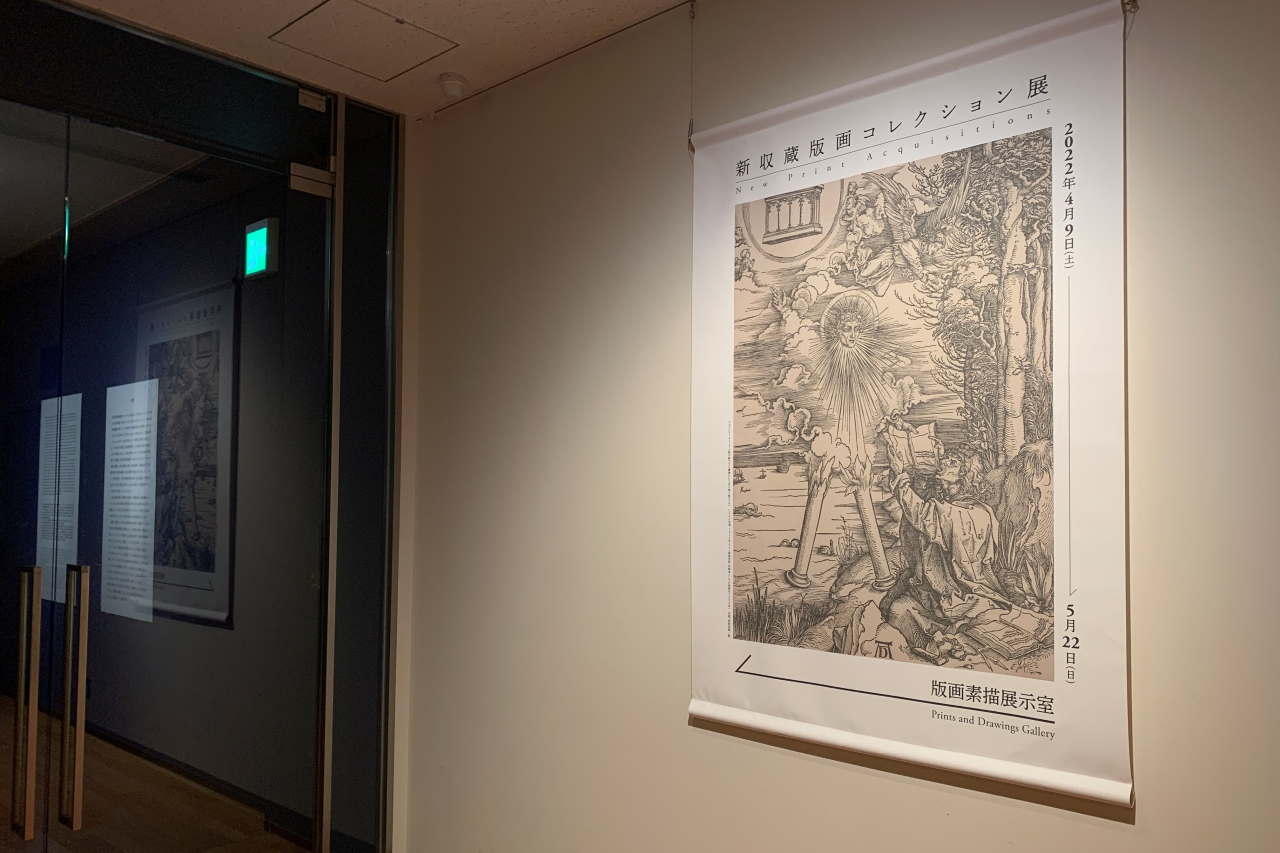
The poster visual is "St. John who devours books" from Albrecht Durer's "Apocalypse".
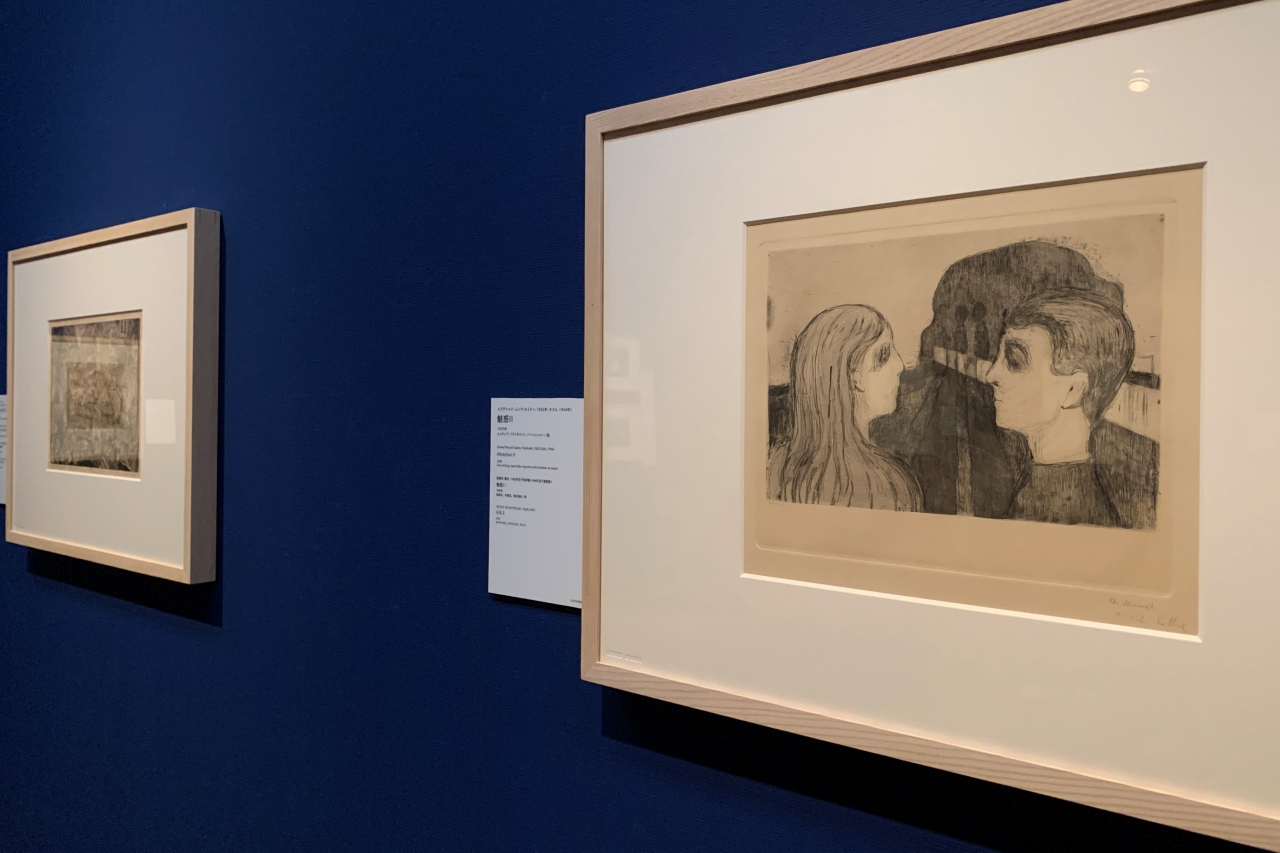
(Right photo) Edvard Munch << Fascination II >> 1895, Etching, Drypoint, Burnisher / Paper
From June 4th, "National Museum of Western Art Renewal Opening Memorial Nature and People Dialogue Friedrich, Monet, Van Gogh to Richter" will be held
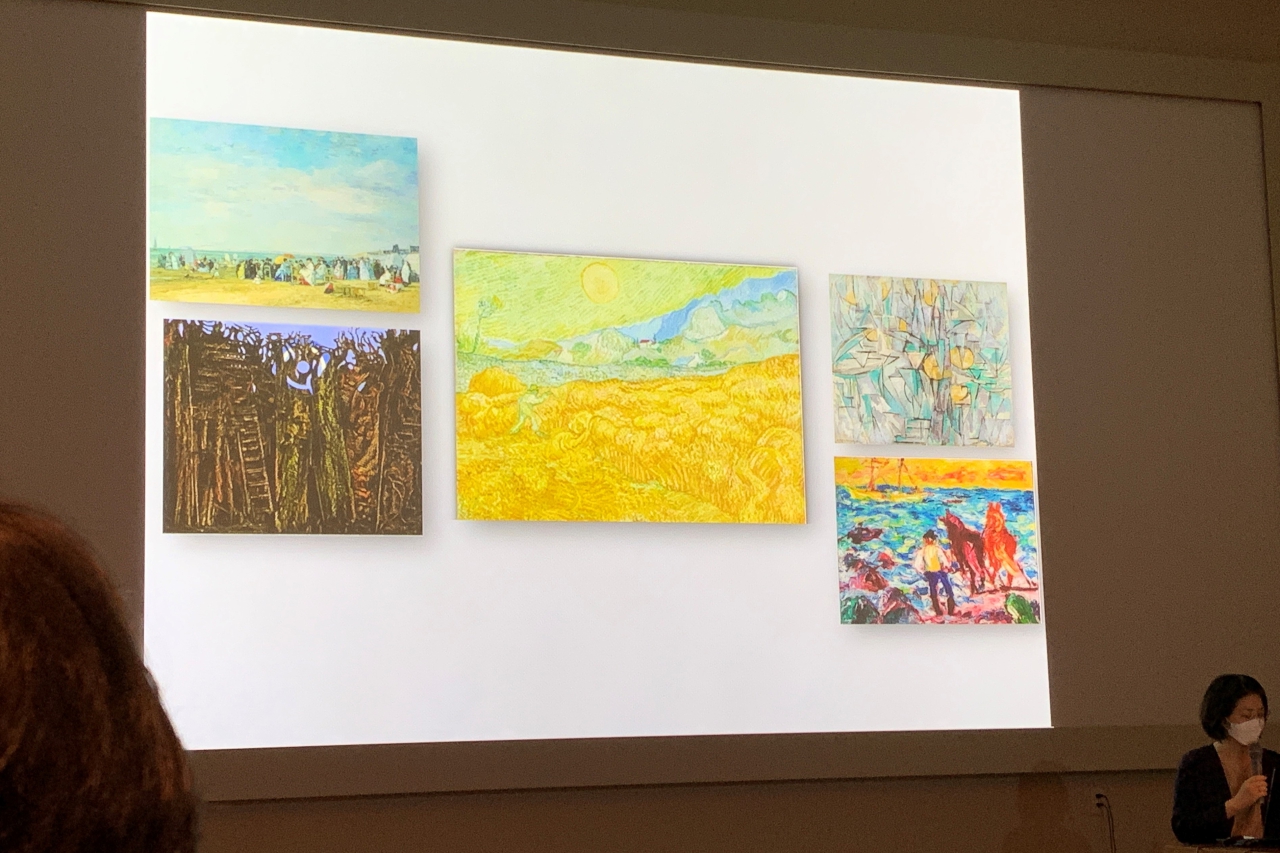
State of press conference
At the press conference, a special exhibition "National Museum of Western Art Renewal Opening Memorial", which is scheduled to be held from June 4, 2022, was born from a joint project with the Volkwang Museum in Germany. From Friedrich, Monet, Goch to Richter. Also introduced.
From the collections of both buildings, more than 100 paintings, drawings, prints and photographs from German Romanticism to 20th century paintings are exhibited, centered on Impressionists and Post-Impressionists. It introduces the development of sensibility and artistic expression for nature in modern times, which was born from the dialogue between nature and people (dialog).
Van Gogh's masterpiece of landscape painting, "Pruning (Wheat field behind Saint-Paul Hospital, where there are pruners)" is coming to Japan for the first time , and the Finnish painter Gallen, who is attracting worldwide attention. Carrera's work is also released for the first time in Japan. You can enjoy a variety of natural expressions by co-starring masters such as Manet, Signac, Munch, Hodler, and Ernst.
The National Museum of Western Art has made a fresh start. Before viewing, please enjoy the front yard where you can feel the thought of Le Corbusier.
■ National Museum of Western Art Information
Location: 7-7 Ueno Park, Taito-ku, Tokyo
Opening hours: 9: 30-17: 30 (until 20:00 on Fridays and Saturdays) * Admission is 30 minutes before closing
Official site: https://www.nmwa.go.jp/jp/
・ Small exhibition "Toward Harmony: The Second Machine Age of Le Corbusier Art-From the Taisei Collection"
Session: April 9th (Sat) -September 19th (Monday / holiday), 2022
Venue: National Museum of Western Art, New Building, 1st floor, 1st exhibition room
・ Small exhibition "New Collection Print Collection Exhibition"
Session: April 9th (Sat) -May 22nd (Sun), 2022
Venue: National Museum of Western Art New Building 2nd Floor Print Drawing Exhibition Room
・ Special exhibition "National Museum of Western Art Reopening Memorial Nature and People Dialogue Friedrich, Monet, Van Gogh to Richter"
Session: June 4th (Sat) -September 11th (Sun), 2022
Venue: National Museum of Western Art
* Please check the official website for closed days and admission fees.
* The information in this article is as of the date of publication (2022/4/9).
<Past coverage articles>
Click here for a list


